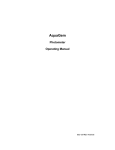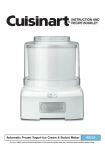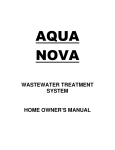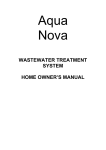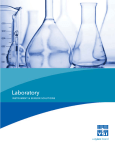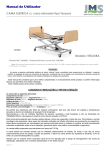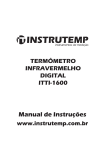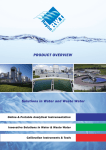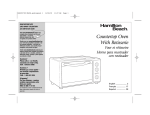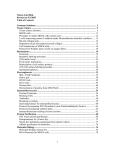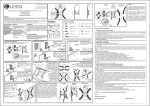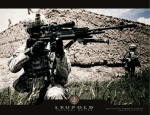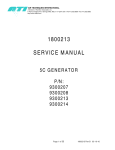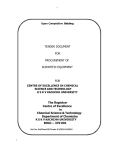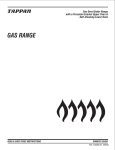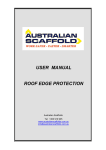Download User manual TM63
Transcript
TECO Tel.: +47 67 200 300 www.teco.no TM 63 Spectrophotometer Operating Manual TECO TECO MARITIME AS Operating Manual Contents Page Introduction Instrument Description Instrument Specification Safety 3 4 5 Installation Unpacking Installation Displays Controls Inputs/Outputs 6 6 7 8 9 Operation Initial Set-Up Sample Measurement Basic Operating Instructions Permanganate Time Test (P.001) Platinum-Cobalt Colour (P.002) Hydrocarbons (P.003) Chloride in Methanol (P.004) Chloride in Water (P.211) COD Low Range (P.213) COD Medium Range (P.214) COD High Range (P.215) 10 10 11 12 13 14 15 16 18 20 22 Maintenance General Light Source Replacement 23 24 Optional Accessories Optional Accessories Spares 25 25 EC Declaration of Conformity 26 TECO Maritime AS P.O.Box 462, N-1327 Lysaker, Norway. Tel: +47 67 200 380, Fax: +47 67 200 381, e-mail: [email protected] Web: http://www.teco.no/ Page 2 of 26 TECO TECO MARITIME AS TECO (Wall Wash) Spectrophotometer We have upgraded existing software and hardware. The result is a new instrument capable to read lower value then our previous models, a requirement as the specification is getting ever more strict. It is specially designed to work alongside your existing testing work instructions. Consequently, for the successful use of the kit, there becomes no need to learn new chemical techniques and no need to purchase additional expensive chemical reagents and laboratory glassware. With this in mind, the kit is equally useful to both inexperienced users, who have no prior knowledge of how to test a wall wash sample and experienced users. In all cases, the test sample is compared against a reference sample that is assigned a reading of ZERO units, to create a result that is effectively the difference between the two samples. With respect to the testing of methanol wall wash samples, this has the added benefit of allowing an operator to carry out a successful wall wash analysis, even if the methanol is slightly contaminated to start with. There is no need to prepare calibration standards at all, either to check against a test sample or to check a particular program. All calibration data is stored in the memory of the spectrophotometer. The whole instrument may be recalibrated in a matter of minutes though, using a very straightforward procedure that is well documented with the instrument operating instructions. Quality standards of bulk chemical cargo have increased dramatically over the past 10 years, which is reflected in the ever more demanding inspections, loading and discharging quality control specifications. Chemical cargo suppliers, receivers and inspection companies now routinely rely on state of the art analytical laboratory instrumentation to control quality specification. The TECO portable laboratory test kit addresses this problem in the form of a fully portable, purpose built, visible spectrophotometer that is especially designed to be used by personnel not familiar with using instrumentation of this nature. The spectrophotometer is supplied with a unique software package that enables the kit to determine the following key analytical tests, in line with the appropriate ASTM standards: APHA Colour according to ASTM D 1209 Hydrocarbon according to ASTM D 1722 Potassium Permanganate Time Test in accordance with ASTM D 1363 Inorganic Chloride by standard acidified silver nitrate Chemical Oxygen Demand (COD) Chloride in Water according to EPA method number 325.3 (1983) Tests that are reliably accepted in the shipping industry as being the essential methanol wall wash test specifications. Furthermore, the nature of the instrument is such that it can be readily adapted to incorporate new software, relating to new and updated programmes. TECO Maritime AS P.O.Box 462, N-1327 Lysaker, Norway. Tel: +47 67 200 380, Fax: +47 67 200 381, e-mail: [email protected] Web: http://www.teco.no/ Page 3 of 26 TECO TECO MARITIME AS Dual Display A customised Liquid Crystal Display gives simultaneous readout of wavelength and %Transmittance, Absorbance or Concentration. Concentration can be found by calibration to a standard or by direct factor entry. Error messages, prompts, mode indication and a choice of concentration units are presented in an easily understood format. Ease Of Use The simple keypad layout and operating protocols are designed to enable reliable operation by unfamiliar users. Photometric calibration, including 0% Transmittance is performed by a single key press. Comprehensive Specification The TECO Spectrophotometer boasts an impressive optical performance for a product of this type. Stray light is minimised by the automatic activation of internal filters, whilst the narrow 10nm bandwidth provides the high degree of selectivity essential for most analytical applications. A precision stepper motor gives excellent positional control of the optical grating ensuring wavelength selection is both accurate and highly repeatable. Fully GLP Compliant The TECO product is designed and manufactured under stringent quality control conditions in an ISO 9001 environment. The TECO Spectrophotometer is supported by traceable calibration standards to provide the on-going assurance of accuracy required by Good Laboratory Practice (GLP). A wavelength calibration routine is performed at switch on and a 0%T setting is performed automatically during all calibration routines. This product complies fully with EEC and US directives relating to ESD/EMC emission and susceptibility. Full Interfacing Capability There is full RS232 interfacing for connection, via industry standard connectors to printer or PC. Results can be downloaded by a single touch of the print key. The bi-directional interface also allows remote interrogation and control of the TECO Spectrophotometer. An analog output is provided for connection to a chart recorder. Wavelength Range Resolution Accuracy Bandwidth Absorbance Range Resolution Transmittance Range Resolution Stray Light Photometric Accuracy Concentration Range Resolution Units Factor Photometric Noise Levels Photometric Stability Readout 320 - 1000nm 1nm ±2nm 8nm -0.300 to 1.999A 0.001A Outputs 0 to 199.9% 0.1% <0.5% @ 340nm ±1% Light Source Input Voltage Input Power Size -300 to 1999 Concentration 0.1 / 1 Weight ppm, mg/l, g/l, M, %, blank 0 to 999.9, 1000 to 9999 <1% 1%/Hour after warm-up Custom Liquid Crystal Display Analog (0 to 1999mV) / RS232 serial port Tungsten Halogen 20W 12V 115/230V AC -20% +10% <50W 365(w) x 272(d) x 160(h)mm 6Kgs TECO Maritime AS P.O.Box 462, N-1327 Lysaker, Norway. Tel: +47 67 200 380, Fax: +47 67 200 381, e-mail: [email protected] Web: http://www.teco.no/ Page 4 of 26 TECO TECO MARITIME AS Safety Please read this information carefully prior to installing or using this equipment. 1. The unit described in this manual is designed to be operated only by trained personnel. Any adjustments, maintenance and repair must be carried out as defined in this manual, by a person qualified to be aware of the hazards involved. 2. It is essential that both operating and service personnel employ a safe system of work, in addition to the detailed instructions specified in this manual. 3. The covers on the unit should be only removed by personnel who have been trained, to avoid the risk of shock. 4. References should always be made to the Health and Safety Data supplied with any chemicals used. Generally accepted laboratory procedures for safe handling of chemicals should be employed. 5. If it is suspected that safety protection has been impaired in any way, the unit must be made inoperative and secured against any intended operation. The fault condition should immediately be reported to the appropriate servicing authority. TECO Maritime AS P.O.Box 462, N-1327 Lysaker, Norway. Tel: +47 67 200 380, Fax: +47 67 200 381, e-mail: [email protected] Web: http://www.teco.no/ Page 5 of 26 TECO TECO MARITIME AS Installation 1. Unpacking Remove the TM63 from the packaging and ensure the following items are present: 1.Teco TM63 Spectrophotometer (638-001) 2.Instrument Manual (638-015) 3.Mains Cable 4.Glass Cuvettes Two 10x50mm (035-087) 5.Pack of Ten 30 ml sample vials (060-398) 6.’Aquanova’ Sample Holder (637-051) 7.Adjustable Length Cuvette Tray (630-005) 8.Optional Accessories (as ordered) Any shortages or damage should be reported immediately to the Manufacturer or supplier. 2. Installation Mains Supply The TM63 Spectrophotometer is designed to operate on 115/230 V a.c. supplies (-20%+10%) 50/60Hz. The standard 2 metre mains cable supplied with the unit is fitted with an IEC type connector, which can be plugged directly into the POWER IN socket on the rear panel. The mains fuse is housed within the POWER IN socket. When replacing the fuse, the unit should be disconnected from the mains supply. In the event of the fuse failing after replacement it is advisable to consult with the Manufacturer or supplier before proceeding further. Fuse Rating 2A ‘F’ (fast blow type) Note: The unit should be positioned within 1.5 metres of an earthed mains supply. Voltage Select Note: When changing the voltage select switch position always ensure the fuse rating is correct. Before attempting to change the voltage select disconnect the instrument from the mains supply. Withdraw the fuse holder from the power input socket and remove the fuse. Extract the grey fuse retainer and rotate so that the correct voltage is visible through the aperture in the fuse holder. Replace the fuse container in its holder, fit the correct fuse and push assembly back into the power input socket. Mains Connections A suitable plug should be connected to the 3 wires on the mains lead. These are colour coded to conform to the internationally recognised standard such that: BROWN BLUE GREEN/YELLOW LIVE NEUTRAL EARTH IMPORTANT: THE UNIT MUST BE EARTHED. The Green/Yellow wire in the a.c. supply cable must be connected to a properly grounded terminal. TECO Maritime AS P.O.Box 462, N-1327 Lysaker, Norway. Tel: +47 67 200 380, Fax: +47 67 200 381, e-mail: [email protected] Web: http://www.teco.no/ Page 6 of 26 TECO TECO MARITIME AS Displays 1. Primary display area – Transmission, Absorbance, Concentration 2. Primary display adjust annunciator 3. Secondary display area – Wavelength, Factor, Method 4. Primary display units 5. Secondary display adjust annunciator 6. Operation with PC 7. Menu options - %T, ABS CONC FACTOR UNITS 8. Menu pointers (for 7) TECO Maritime AS P.O.Box 462, N-1327 Lysaker, Norway. Tel: +47 67 200 380, Fax: +47 67 200 381, e-mail: [email protected] Web: http://www.teco.no/ Page 7 of 26 TECO TECO MARITIME AS Controls 1. Used to adjust values on the selected display 2. Used to move horizontally between menu options 3. Used to select the displayed menu option 4. Initiates a calibration routine 5. Print key. Provides a printout of the current reading with an incremental sample number. When pressed for the first time after a calibration the printout will give calibration information. The incremental sample number will be reset after a calibration. TECO Maritime AS P.O.Box 462, N-1327 Lysaker, Norway. Tel: +47 67 200 380, Fax: +47 67 200 381, e-mail: [email protected] Web: http://www.teco.no/ Page 8 of 26 TECO TECO MARITIME AS Inputs/Outputs 1. LAMP ACCESS PANEL This panel allows the user to gain access to the tungsten halogen lamp when replacement is necessary. NOTE: The Lamp Access Panel and all ventilation slots must not be covered or obstructed at any time. 2. ROCKER SWITCH On/Off switch for the unit. 3. POWER IN SOCKET IEC type connection socket for mains cable. 4. OUTPUT SOCKET Analogue output. 5. OUTPUT SOCKET Output socket for (25 way) RS232. TECO Maritime AS P.O.Box 462, N-1327 Lysaker, Norway. Tel: +47 67 200 380, Fax: +47 67 200 381, e-mail: [email protected] Web: http://www.teco.no/ Page 9 of 26 TECO TECO MARITIME AS Operation 1. Initial Set-Up Note: If the unit is in continuous use it is recommended that it should be left switched on to obtain maximum lamp life. Do not the open the sample chamber door during initialisation. Connect the unit to the correct mains supply and switch on. After switch on, the TM63 Spectrophotometer automatically re-aligns the monochromator at zero order wavelength. During this initialisation, the instrument displays CAL on the primary display and a moving dash on the secondary display. After calibration, the unit will then go to the last wavelength used and enter the measurement mode last used. The following error conditions are possible if the TM63 fails to find a zero order peak: ERR4 Low zero order light level is detected. The instrument has failed to find a zero order peak. Possible causes of this error are that the lamp has failed or that a sample has been left in the unit, which is absorbing the zero order light. ERR5 No light level detected. The instrument has failed to find the zero order peak. Possible causes of this error are that the lamp has failed or that a sample has been left in the unit, which is absorbing the zero order light. ERR6 No dark level detected. The instrument checks the region below 320nm, which should have no optical throughput. If this region cannot be found the most likely cause is that the sample chamber lid is not completely closed. 2. Sample Measurement The TM63 Spectrophotometer has eight pre-programmed methods; these are listed inside the sample chamber. Each method has a pre-calculated factor for the calculation of the concentration from the absorbance reading. Use of the Pre-programmed Methods The methods are selected by using the UP and DOWN arrow keys. The correct wavelength and unit of measure will automatically be selected. Transferring to the ABS or %T menu option using the LEFT and RIGHT arrow keys will display the wavelength of the method and the actual absorbance or %transmission values of the solution. Comprehensive instructions for each of the programmed methods are given within this manual. The following error codes are possible after a calibration: ERR1 Dark cal error. This error occurs when the instrument closes a shutter to block the light entering the sample chamber. If the detector output does not fall to a level normally associated with a dark cal then this error is indicated. The most likely cause is that the sample chamber lid is not fully closed. ERR2 Light cal error. This error indicates that there is insufficient light to calibrate to 100%. The most likely cause is that light at the selected wavelength is being absorbed by a sample in the sample chamber. The error can also be caused if the lamp has failed. A calibration resets the sample number to unity. TECO Maritime AS P.O.Box 462, N-1327 Lysaker, Norway. Tel: +47 67 200 380, Fax: +47 67 200 381, e-mail: [email protected] Web: http://www.teco.no/ Page 10 of 26 TECO TECO MARITIME AS Basic Operating Instructions The following instructions are written to familiarize the user with the most common responses of the instrument. These instructions will allow immediate operation of the instrument but should not be used in place of the manufacturer’s instrument manual, rather as a convenient reference during the routine operation of the instrument. Powering the Instrument The instrument can be run from either a 120V or 240V mains supply. To ensure that the appropriate voltage has been selected refer to the labelled fuse located on the back panel immediately below the mains socket. To alter the voltage setting, refer to the instrument manual. Instrument operation Instruction Instrument Response Switch the instrument ON using the ON/OFF rocker switch on the back panel. Instrument will follow a self-test and auto calibration routine. Select method number by using the UP and DOWN keys and press ENTER. Displays method number and default concentration unit. Press CAL to zero instrument Zero concentration display Method number Analysis of Test Samples Ensure that the instrument has the appropriate cuvette or sample vial holder fitted within the sample chamber for the test to be carried out. To fit the tray, remove existing tray by loosening the thumb screw located underneath the sample chamber. Remove the tray and fit alternative tray, tighten thumb screw until secure. Prepare any test sample in an appropriate manner and select the required test method using the information described above. Transfer the reference sample into one of the matched pair of sample cells. The following instructions now apply: Instruction Instrument Response Insert the relevant reference sample into the instrument. Press CAL Zero concentration display Method number Insert cuvettes or sample tubes containing the prepared test solutions into the instrument to obtain the result as concentration or appropriate unit of measure. TECO Maritime AS P.O.Box 462, N-1327 Lysaker, Norway. Tel: +47 67 200 380, Fax: +47 67 200 381, e-mail: [email protected] Web: http://www.teco.no/ Page 11 of 26 TECO TECO MARITIME AS Permanganate Time Test P.001 Range: Pass or Fail in line with ASTM D 1363 Introduction This test method covers the detection in acetone and methanol of the presence of impurities that reduce potassium permanganate. The permanganate time can be used to judge the presence of oxidisable materials that may be associated with contamination. Principle of the Test Substances react with potassium permanganate in neutral solutions, reducing it to manganese dioxide which is a yellow colour. In the Permanganate Time Test the time required for the colour of the test solution to change to the colour of a standard solution is measured. The colour of the test solution changes from pink-orange to yelloworange. Equipment Required TM63 Spectrophotometer fitted with Adjustable Length Cuvette Tray Constant Temperature Water Bath Visible range glass cuvettes 10x50mm Reagents Required Reagent Grade Methanol Solution of Potassium Permanganate 0.2 g/L (Part number 025 190) (Note: This solution is stable for 12 months when stored in the dark, at less than 250C.) Procedure 1. Switch the TM63 Spectrophotometer on. Select P.001 using the UP and DOWN arrow keys, and press ENTER. Ensure that the instrument has the appropriate cuvette holder fitted; refer to Basic Operating Instructions for additional information. 2. Allow the instrument to warm up for at least 5 minutes and follow these instructions. 3. Prepare a water bath at 150 C ∀ 10C. 4. Fill a sample container with 25mls of the test sample and place it in the bath for at least 2 minutes to allow it to cool to the reaction temperature. 5. Take the sample out of the bath and add 1 ml of the potassium permanganate reagent. Mix the contents of the container and replace in the bath. Note the time. Instruction Instrument Display Select P.001 using the UP and DOWN arrow keys, and press ENTER. P.001 %T Fill glass cuvette with unused reagent grade methanol (‘Blank’) and insert into the instrument, with the mark facing left. Close the sample compartment and 0.0% T press CAL. 6. Remove the cuvette containing the sample blank from the instrument. 7. Fill the matching glass cuvette with the test sample and insert into the instrument, with the mark also facing left. Close the sample compartment lid and read directly the %T PTT result. 8. After each test reading, check that the sample blank still gives an instrument response of 0.0% T . If it does not, leave the cuvette containing the sample blank in the instrument and recalibrate by pressing the CAL key. Interpretation of results. Samples having a reading of less than 43.0% by this procedure fail this test. Samples having a reading greater than 43.0% by this procedure pass this test. Interferences: a)Hazy and/or coloured test sample b)Extreme pH TECO Maritime AS P.O.Box 462, N-1327 Lysaker, Norway. Tel: +47 67 200 380, Fax: +47 67 200 381, e-mail: [email protected] Web: http://www.teco.no/ Page 12 of 26 TECO TECO MARITIME AS Pt-Co Colour P.002 Range: APHA 5 – 50 in line with ASTM D 1209 on Platinum – Cobalt Scale Introduction The presence or absence of colour is an indication of the cleanliness of the shipping or storage container. Principle of the Test This procedure is a visual method for the measurement of colour in which the colour producing species has absorption characteristics nearly identical with those of platinum-cobalt colour standards. The colour of the test solution is compared to an embedded calibration of absorbance versus colour standard number. Equipment Required TM63 Spectrophotometer fitted with Adjustable Length Cuvette Tray Visible Range Glass Cuvettes 10x50mm Reagents Required Reagent Grade Methanol Procedure 1. Switch the TM63 Spectrophotometer on. Select P.002 using the UP and DOWN arrow keys and press ENTER. Ensure that the instrument has the appropriate cuvette holder fitted; refer to Basic Operating Instructions for additional information. 2. Allow the instrument to warm up for at least 5 minutes and follow these instructions. Instruction Instrument Display Select programme P.002 using the UP and DOWN arrow keys and press P.002 ENTER. Fill glass cuvette with unused reagent grade methanol (‘Blank’) and insert into instrument with the mark facing left. Close the sample compartment and press CAL. 0 3. 4. 5. Remove the cuvette containing the sample blank from the instrument. Fill the matching glass cuvette with the test sample and insert into the instrument, with the mark also facing left. Close the sample compartment lid and read directly the Pt-Co colour. After each test reading, check that the sample blank still gives an instrument response of 0. If it does not, leave the cuvette containing the sample blank in the instrument and recalibrate by pressing the CAL key Interpretation of results. The colour of the test sample is read directly from the instrument and should be reported either as an exact multiple of 5 or “lighter than” the next highest multiple of 5, whichever is the most appropriate. Interferences: a) Hazy and/or coloured test sample b) The presence of excessive detergents. c) The presence of excessive Phosphates. d) The presence of excessive water immiscible contaminants. TECO Maritime AS P.O.Box 462, N-1327 Lysaker, Norway. Tel: +47 67 200 380, Fax: +47 67 200 381, e-mail: [email protected] Web: http://www.teco.no/ Page 13 of 26 TECO TECO MARITIME AS Hydrocarbons P.003 Range: Pass or Fail in line with ASTM D 1722 Introduction The test provides an indication of the presence of water-immiscible contamination. Principle of the Test The sample is diluted with the specified volume of water and the resulting mixture is examined for cloudiness or turbidity. Equipment Required TM63 Spectrophotometer fitted with Adjustable Length Cuvette Tray Visible Range Glass Cuvettes 10x50mm Reagents Required Deionised water Reagent Grade Methanol Procedure 1. Switch the TM63 Spectrophotometer on. Select P.003 using the UP and DOWN arrow keys and press ENTER. Ensure that the instrument has the appropriate cuvette holder fitted; refer to Basic Operating Instructions for additional information. 2. Allow the instrument to warm up for at least 5 minutes and follow these instructions. 3. Dilute part of the test sample by the specified volume of water, in a suitable sample tube. 4. Invert the tube once or twice to mix the water and methanol. 5. Prepare a reagent blank to run concurrently, by following steps 2 and 3 on unused reagent grade methanol. Leave to stand for 15 minutes. 6. After 15 minutes, follow these steps: Instruction Select P.003 using UP and DOWN arrow keys and press ENTER. Instrument Display P.003 FAU Fill glass cuvette with prepared blank and insert into instrument, with the mark facing left. Close the sample compartment and press CAL 0 FAU 7. 8. 9. Remove the cuvette containing the sample blank from the instrument. Fill the second glass cuvette with the test sample and insert into the instrument, with the mark also facing left. Close the sample compartment lid and read directly the FAU Hydrocarbons reading. After each test reading, check that the sample blank still gives an instrument response of 0 FAU. If it does not, leave the cuvette containing the sample blank in the instrument and recalibrate by pressing the CAL key Interpretation of results. Samples having a reading of 0 by this procedure pass this test. Samples having a reading of greater than 0 by this procedure fail this test. Interferences: a) Hazy test sample b) The presence of excessive detergents TECO Maritime AS P.O.Box 462, N-1327 Lysaker, Norway. Tel: +47 67 200 380, Fax: +47 67 200 381, e-mail: [email protected] Web: http://www.teco.no/ Page 14 of 26 TECO TECO MARITIME AS Chloride in Methanol P.004 Range: 0.2 – 20 ppm by weight Introduction Chloride, in the form of (Cl-) ion is one of the major inorganic anions present in water and wastewater. Principle of the Test The acidified silver nitrate solution precipitates quantitatively the chloride present as silver chloride, which is measured as turbidity. Equipment Required TM63 Spectrophotometer fitted with Adjustable Length Cuvette Tray Visible Range Glass Cuvettes 10x50mm Reagents Required Reagent Grade Methanol Acidified Silver Nitrate Reagent (Part Number 025-191) or alternatively: Preparation of Reagent Dissolve 10 g of silver nitrate in approximately 250 ml of de-ionised water. Add with great care 142 ml of 70 % Nitric Acid and dilute the whole solution to 500 ml with de-ionised water. Store this solution in a dark bottle. Procedure 1. Switch the TM63 Spectrophotometer on. Select P.004 using the UP and DOWN arrow keys and press ENTER. Ensure that the instrument has the appropriate cuvette holder fitted; refer to Basic Operating Instructions for additional information. 2. Allow the instrument to warm up for at least 5 minutes and follow these instructions. 3. Transfer 25 ml of the test solution into an appropriate sample tube. 4. Add five drops of acidified silver nitrate reagent. 5. Prepare a reagent blank to run concurrently, by following steps 2 and 3 on unused reagent grade methanol. Leave to stand for 15 minutes. 6. After 15 minutes, follow these steps: Instruction Instruction Select P.004 using the UP and DOWN arrow keys and press ENTER. P.004 Ppm Fill glass cuvette to with prepared blank and insert into the instrument, with the mark facing to the left. Close the sample compartment lid and press CAL. 0.0 ppm 7. 8. 9. Remove the cuvette containing the sample blank from the instrument. Fill the matching glass cuvette with the test sample and insert into the instrument, with the mark also facing left. Close the sample compartment lid and read directly the ppm Chloride. After each test reading, check that the sample blank still gives an instrument response of 0.0 ppm. If it does not, leave the cuvette containing the sample blank in the instrument and recalibrate by pressing the CAL key. Interpretation of results. The chloride content of the test sample in ppm, is read directly from the instrument. Interferences: a) Hazy and/or coloured test sample b) The presence of excessive detergents. c) The presence of excessive Phosphates. d) The presence of excessive water immiscible contaminants. TECO Maritime AS P.O.Box 462, N-1327 Lysaker, Norway. Tel: +47 67 200 380, Fax: +47 67 200 381, e-mail: [email protected] Web: http://www.teco.no/ Page 15 of 26 TECO TECO MARITIME AS Chloride in Water P.211 Range 0-20mg/l as Cl- Introduction Chloride is one of the major inorganic anions in water and wastewater. A high chloride level may harm metallic pipes and structures and growing plants. Principle of the Test Chloride ions react with mercuric thiocyanate to produce mercuric chloride and liberate thiocyanate ions. In the presence of ferric salts, these thiocyanate ions produce a characteristic orange colour. The intensity of this colour is proportional to the concentration of thiocyanate ions and hence to the concentration of chloride ions. Contents of the Chloride Test Kit Chloride Reagent 1 30ml Chloride Reagent 2 30ml Chloride Standard 100mg/l 30ml Tube marked at 5ml Reorder Details: Chloride Colorimetric Test Kit 025-211 Chloride Standard 100mg/l - 2 x 65ml 025-261 Tubes marked at 5ml Pack of 88 060-381 Equipment Required Tubes marked at 5ml TM63 Spectrophotometer fitted with ‘Aquanova’ Sample Tube Holder Equipment to accurately make up a range of diluted standards for calibration (optional). Health and Safety Chloride Reagent 1 – Toxic by inhalation and if swallowed, harmful in contact with skin, flammable, contains methanol and mercuric thiocyanate. Chloride Reagent 2 – Irritating to eyes and skin, contains nitric acid. Chloride Standard – Not considered hazardous. Minimum protection of laboratory coat, gloves and safety glasses/goggles must be worn. First Aid – Skin Contact – Remove contaminated clothing if possible and flush skin with running water for at least 10 minutes. Seek medical attention if there are burns. Eye Contact – Bathe eye with running water for at least 15 minutes. Seek medical attention. Ingestion – Do not induce vomiting. If conscious, sit or lie casualty down and give plenty of water to drink. If unconscious, check breathing and apply artificial respiration if necessary or place in recovery position, if breathing OK. Transfer to hospital as soon as possible. Inhalation – Remove casualty from exposure, ensuring one’s own safety. If unconscious, treat as for ingestion. If conscious, sit or lie casualty down. If breathing becomes bubbly, provide oxygen if available. Transfer to hospital as soon as possible. TECO Maritime AS P.O.Box 462, N-1327 Lysaker, Norway. Tel: +47 67 200 380, Fax: +47 67 200 381, e-mail: [email protected] Web: http://www.teco.no/ Page 16 of 26 TECO TECO MARITIME AS Instrument and Standard Preparation Ensure that the instrument has the appropriate cuvette holder is fitted within the sample chamber, which is designed to hold the 5 ml reaction tube. To fit the tray, remove existing cuvette tray by loosening the thumb screw located underneath the sample chamber. Remove the tray and fit alternative tray, tighten thumb screw until secure. If using a pre-programmed methodology on the TM63, a blank standard (deionised water) and ideally one standard of known concentration should be prepared, to check that the sample preparation and factor are correct. If you do not have this facility, or wish to work without it, at least five standards with known concentration should be prepared over the working range. A calibration graph, concentration vs. absorbance, should then be constructed and used to interpret the unknown sample concentrations. Instructions 1. Select method P.211 using the UP and DOWN arrow keys and press ENTER. 2. Allow the instrument to warm up for at least 5 minutes and follow these instructions. 3. Rinse a tube with the test solution and fill to the 5ml mark. 4. Rinse a tube with clean deionised water and fill to the 5ml mark (‘Blank’). 5. Add 12 drops of Chloride Reagent 1 to each tube. Replace cap and invert to mix. 6. Add 12 drops of Chloride Reagent 2 to each tube. Replace cap and invert to mix. 7. Allow tubes to stand for 5 minutes for colour development. 8. Insert the tube containing the Blank into the instrument. Close the sample compartment and press CAL. 9. Remove the tube containing the Blank from the instrument. 10. Insert the tubes containing the prepared sample or standard solution. 11. Close the compartment lid and directly read the chloride concentration. Notes a. For chloride concentrations higher than 20mg/l the sample may be suitably diluted with deionised water prior to analysis. The result then being multiplied by the dilution factor. b. If the samples are turbid or contain any particulate matter, filtration using a 0.45µm glass fibre filter is recommended. c. When preparing a calibration reference solution, it is important that the dilutions are carried out accurately, using calibrated equipment. d. The kit is designed for the analysis of potable or ‘clean’ water and ‘dirty’ samples (i.e. high salt concentration) will need to be filtered or treated appropriately. e. This method is equivalent to EPA method number 325.3(1983). For further information refer to www.teco.com, or for any further assistance please contact your distributor or [email protected] TECO Maritime AS P.O.Box 462, N-1327 Lysaker, Norway. Tel: +47 67 200 380, Fax: +47 67 200 381, e-mail: [email protected] Web: http://www.teco.no/ Page 17 of 26 TECO TECO MARITIME AS COD Colorimetric Test – Low Range P.213 Range 0-150 mg/l as O2 Introduction Chemical Oxygen Demand shows the general level of contamination in wastewater. The test for Chemical Oxygen Demand (COD) determines the quantity of oxygen required to oxidise the organic matter in a sample under specific conditions of oxidising agent, temperature and time. Principle of the Test Organic and oxidisable inorganic substances are oxidised by potassium dichromate in sealed tubes at reflux temperatures for 2 hours. The excess of this reagent, after oxidation is complete, is measured spectrophotometrically and is proportional to the Chemical Oxygen Demand. Contents of the Test Kit COD LR Vials (25 vials) Reorder Details: COD Colorimetric Test Kit – Low Range Digestor and 2 dri-blocks COD Sample Vial Holder 025-213 037-061 637-057 Equipment Required TM63 Spectrophotometer fitted with COD sample vial holder Digestion unit capable of maintaining 148ºC for 2 hours Health and Safety COD Reagent - Corrosive, causes severe burns. Toxic, and an accumulative hazard. Contains sulphuric acid and mercuric sulphate. Harmful by inhalation, in contact with skin or if swallowed. Minimum protection of laboratory coat, gloves and safety glasses/goggles must be worn. Due regard to safety should be take in siting the digestion unit due to the high heat and sealed reaction vessels. A safety shield is recommended. First Aid – Skin Contact – Remove contaminated clothing if possible and flush skin with running water for at least 10 minutes. Seek medical attention if there are burns. Eye Contact – Bathe eye with running water for at least 15 minutes. Seek medical attention. Ingestion – Do not induce vomiting. If conscious, sit or lie casualty down and give plenty of water to drink. If unconscious, check breathing and apply artificial respiration if necessary or place in recovery position, if breathing OK. Transfer to hospital as soon as possible. Inhalation – Remove casualty from exposure, ensuring one’s own safety. If unconscious, treat as for ingestion. If conscious, sit or lie casualty down. Transfer to hospital as soon as possible. TECO Maritime AS P.O.Box 462, N-1327 Lysaker, Norway. Tel: +47 67 200 380, Fax: +47 67 200 381, e-mail: [email protected] Web: http://www.teco.no/ Page 18 of 26 TECO TECO MARITIME AS Standard Preparation A standard is not compulsory for this test and the spectrophotometer should be zeroed on air. 1. If you wish to use a standard it can be prepared as follows: 2. Lightly crush and dry potassium hydrogen phthalate (KHP) to a constant weight at 120°C. 3. Dissolve 425mg in distilled water and make up to 1000ml. This makes a 500mg O2/L as KHP has a theoretical COD value of 1.176mg O2/mg. 4. This solution can then be diluted to prepare a series of standards. 5. The standard solution is stable for three months when kept refrigerated, with the absence of visible biological growth. Instructions 1. Turn the digestion unit ON, set to 148°C. 2. Whilst holding the tube at an angle of 45 degrees, transfer 2ml of sample and 0.5ml of deionised water into one of the pre-filled reagent test tubes, allow sample and water to run down the inside of the glass tube to give 2 discrete layers. This helps to prevent the sample/water mixing with the reagent before the tube is capped as the reaction generates heat. 3. Replace the screw cap, ensuring a good fit. Shake thoroughly but carefully, as the tubes will become hot. 4. Insert the sample tube into the pre-heated digestion unit and incubate for 120 minutes. 5. When the 120 minutes has elapsed, take the samples out of the digestion unit and transfer into a test tube holder to cool. (ATTENTION: Test tubes will be very hot). 6. After 5 minutes and ensuring the caps are tight, invert the tubes twice to mix and then let them cool down to room temperature. This is important to ensure a clear solution for analysis. 7. Select method P.213 using the UP and DOWN arrow keys and press ENTER. 8. Ensure that the instrument has the appropriate cuvette holder fitted, which is designed to hold the COD vials. For additional instructions refer to the Basic Operating Instructions. 9. Allow the instrument to warm up for at least 5 minutes and follow these instructions. 10. Zero the absorbance reading of the spectrophotometer using air. Then measure the standards and samples. 11. A concentration result will be displayed, which is obtained by using the embedded calibration factor. Alternatively, construct a calibration graph of absorbance vs. concentration of the standards and blank, and the concentration of unknowns can then be obtained. Disposal The used vials should be retained and stored in the original packaging for professional disposal following environmentally responsible methods. It will be necessary to contact your Supplier or Distributor for details of the disposal method. This is due to the mercuric sulphate. Notes a. Turbidity effects may lead to higher COD values being recorded. Therefore it is important in step 6 to wait until the solution is cool and clear. After cooling, there may still be some undissolved matter in the test tube. Allow this to settle to the bottom prior to measurement. b. The sample should contain less then 1000 mg/L chloride. If this is not the case, the sample should be diluted. c. For COD concentrations higher than 150mg/l there are two further kits: Teco COD Colorimetric Test Kit – Medium Range 100-1500mg/l Teco COD Colorimetric Test Kit – High Range 1000-10,000mg/l 025-214 025-215 For further information refer to www.teco.com, or for any further assistance please contact your distributor or [email protected] TECO Maritime AS P.O.Box 462, N-1327 Lysaker, Norway. Tel: +47 67 200 380, Fax: +47 67 200 381, e-mail: [email protected] Web: http://www.teco.no/ Page 19 of 26 TECO TECO MARITIME AS COD Colorimetric Test – Medium Range P.214 Range 100-1500 mg/l as O2 Introduction Chemical Oxygen Demand shows the general level of contamination in wastewater. The test for Chemical Oxygen Demand (COD) determines the quantity of oxygen required to oxidise the organic matter in a sample under specific conditions of oxidising agent, temperature and time. Principle of the Test Organic and oxidisable inorganic substances are oxidised by potassium dichromate in sealed tubes at reflux temperatures for 2 hours. The excess of this reagent, after oxidation is complete, is measured spectrophotometrically and is proportional to the Chemical Oxygen Demand. Contents of the Kit COD MR Vials (25 vials) Reorder Details: COD Colorimetric Test Kit – Medium Range Digestor and 2 dri-blocks COD Sample Vial Holder 025-214 037-061 637-057 Equipment Required TM63 Spectrophotometer fitted with COD sample vial holder Digestion unit capable of maintaining 148ºC for 2 hours Health and Safety COD Reagent - Corrosive, causes severe burns. Toxic, and an accumulative hazard. Contains sulphuric acid and mercuric sulphate. Harmful by inhalation, in contact with skin or if swallowed. Minimum protection of laboratory coat, gloves and safety glasses/goggles must be worn. Due regard to safety should be take in siting the digestion unit due to the high heat and sealed reaction vessels. A safety shield is recommended. First Aid – Skin Contact – Remove contaminated clothing if possible and flush skin with running water for at least 10 minutes. Seek medical attention if there are burns. Eye Contact – Bathe eye with running water for at least 15 minutes. Seek medical attention. Ingestion – Do not induce vomiting. If conscious, sit or lie casualty down and give plenty of water to drink. If unconscious, check breathing and apply artificial respiration if necessary or place in recovery position, if breathing OK. Transfer to hospital as soon as possible. Inhalation – Remove casualty from exposure, ensuring one’s own safety. If unconscious, treat as for ingestion. If conscious, sit or lie casualty down. Transfer to hospital as soon as possible. TECO Maritime AS P.O.Box 462, N-1327 Lysaker, Norway. Tel: +47 67 200 380, Fax: +47 67 200 381, e-mail: [email protected] Web: http://www.teco.no/ Page 20 of 26 TECO TECO MARITIME AS Standard Preparation A standard is not compulsory for this test and the spectrophotometer should be zeroed on air. 1. If you wish to use a standard it can be prepared as follows: 2. Lightly crush and dry potassium hydrogen phthalate (KHP) to a constant weight at 120°C. 3. Dissolve 1275mg in distilled water and make up to 1000ml. This makes a 1500mg O2/L as KHP has a theoretical COD value of 1.176mg O2/mg. 4. This solution can then be diluted to prepare a series of standards. 5. The standard solution is stable for three months when kept refrigerated, with the absence of visible biological growth. Instructions 1. Turn the digestion unit ON, set to 148°C. 2. Whilst holding the tube at an angle of 45 degrees, transfer 2ml of sample and 0.5ml of deionised water into one of the pre-filled reagent test tube, allow sample and water to run down the inside of the glass tube to give 2 discrete layers. This helps to prevent the sample/water mixing with the reagent before the tube is capped as the reaction generates heat. 3. Replace the screw cap, ensuring a good fit. Shake thoroughly but carefully, as the tubes will become hot. 4. Insert the sample tube into the pre-heated digestion unit and incubate for 120 minutes. 5. When the 120 minutes has elapsed, take the samples out of the digestion unit and transfer into a test tube holder to cool. (ATTENTION: Test tubes will be very hot). 6. After 5 minutes and ensuring the caps are tight, invert the tubes twice to mix and then let them cool down to room temperature. This is important to ensure a clear solution for analysis. 7. Select method P.214 using the UP and DOWN arrow keys and press ENTER. 8. Ensure that the instrument has the appropriate cuvette holder fitted, which is designed to hold the COD vials. For additional instructions refer to the Basic Operating Instructions. 9. Allow the instrument to warm up for at least 5 minutes and follow these instructions. 10. Zero the absorbance reading of the spectrophotometer using air. Then measure the standards and samples. 11. A concentration result will be displayed, which is obtained by using the embedded calibration factor. Alternatively, construct a calibration graph of absorbance vs. concentration of the standards and blank, and the concentration of unknowns can then be obtained. Disposal The used vials should be retained and stored in the original packaging for professional disposal following environmentally responsible methods. It will be necessary to contact your Supplier or Distributor for details of the disposal method. This is due to the mercuric sulphate. Notes a. Turbidity effects may lead to higher COD values being recorded. Therefore it is important in step 6 to wait until the solution is cool and clear. After cooling, there may still be some undissolved matter in the test tube. Allow this to settle to the bottom prior to measurement. b. The sample should contain less then 1000 mg/L chloride. If this is not the case, the sample should be diluted. c. For COD concentrations outside the range there are two further kits: Teco COD Colorimetric Test Kit – Low Range 0 - 150mg/l Teco COD Colorimetric Test Kit – High Range 1000 - 10,000mg/l 025-213 025-215 For further information refer to www.teco.com, or for any further assistance please contact your distributor or [email protected] TECO Maritime AS P.O.Box 462, N-1327 Lysaker, Norway. Tel: +47 67 200 380, Fax: +47 67 200 381, e-mail: [email protected] Web: http://www.teco.no/ Page 21 of 26 TECO TECO MARITIME AS COD Colorimetric Test – High Range P.215 Range 1000-10,000 mg/l as O2 Introduction Chemical Oxygen Demand shows the general level of contamination in wastewater. The test for Chemical Oxygen Demand (COD) determines the quantity of oxygen required to oxidise the organic matter in a sample under specific conditions of oxidising agent, temperature and time. Principle of the Test Kit Organic and oxidisable inorganic substances are oxidised by potassium dichromate in sealed tubes at reflux temperatures for 2 hours. The excess of this reagent, after oxidation is complete, is measured spectrophotometrically and is proportional to the Chemical Oxygen Demand. Contents of the Kit COD HR Vials (25vials) Reorder Details: COD Colorimetric Test Kit – High Range Digestor and 2 dri-blocks COD Sample Vial Holder 025-215 037-061 637-057 Equipment Required TM63 Spectrophotometer fitted with COD sample vial holder Digestion unit capable of maintaining 148ºC for 2 hours Health and Safety COD Reagent - Corrosive, causes severe burns. Toxic, and an accumulative hazard. Contains sulphuric acid and mercuric sulphate. Harmful by inhalation, in contact with skin or if swallowed. Minimum protection of laboratory coat, gloves and safety glasses/goggles must be worn. Due regard to safety should be take in siting the digestion unit due to the high heat and sealed reaction vessels. A safety shield is recommended. First Aid – Skin Contact – Remove contaminated clothing if possible and flush skin with running water for at least 10 minutes. Seek medical attention if there are burns. Eye Contact – Bathe eye with running water for at least 15 minutes. Seek medical attention. Ingestion – Do not induce vomiting. If conscious, sit or lie casualty down and give plenty of water to drink. If unconscious, check breathing and apply artificial respiration if necessary or place in recovery position, if breathing OK. Transfer to hospital as soon as possible. Inhalation – Remove casualty from exposure, ensuring one’s own safety. If unconscious, treat as for ingestion. If conscious, sit or lie casualty down. Transfer to hospital as soon as possible. TECO Maritime AS P.O.Box 462, N-1327 Lysaker, Norway. Tel: +47 67 200 380, Fax: +47 67 200 381, e-mail: [email protected] Web: http://www.teco.no/ Page 22 of 26 TECO TECO MARITIME AS Standard Preparation A standard is not compulsory for this test and the spectrophotometer should be zeroed on air. If you wish to use a standard it can be prepared as follows: 1. Lightly crush and dry potassium hydrogen phthalate (KHP) to a constant weight at 120°C. 2. Dissolve 8.5g in distilled water and make up to 1000ml. This makes a 10,000mg O2/L as KHP has a theoretical COD value of 1.176mg O2/mg. 3. This solution can then be diluted to prepare a series of standards. 4. The standard solution is stable for three months when kept refrigerated, with the absence of visible biological growth. Instructions 1. Turn the digestion unit ON, set to 148°C. 2. Whilst holding the tube at an angle of 45 degrees, transfer 2ml of sample and 0.5ml of deionised water into one of the pre-filled reagent test tube, allow sample and water to run down the inside of the glass tube to give 2 discrete layers. This helps to prevent the sample/water mixing with the reagent before the tube is capped as the reaction generates heat. 3. Replace the screw cap, ensuring a good fit. Shake thoroughly but carefully, as the tubes will become hot. 4. Insert the sample tube into the pre-heated digestion unit and incubate for 120 minutes. 5. When the 120 minutes has elapsed, take the samples out of the digestion unit and transfer into a test tube holder to cool. (ATTENTION: Test tubes will be very hot). 6. After 5 minutes and ensuring the caps are tight, invert the tubes twice to mix and then let them cool down to room temperature. This is important to ensure a clear solution for analysis. 7. Select method P.215 using the UP and DOWN arrow keys and press ENTER. 8. Ensure that the instrument has the appropriate cuvette holder fitted, which is designed to hold the COD vials. For additional instructions refer to the Basic Operating Instructions. 9. Zero the absorbance reading of the spectrophotometer using air. Then measure the standards and samples. 10. A concentration result will be displayed, which is obtained by using the embedded factor. Alternatively, construct a calibration graph of absorbance vs. concentration of the standards and blank and the concentration of unknowns can then be obtained. Disposal The used vials should be retained and stored in the original packaging for professional disposal following environmentally responsible methods. It will be necessary to contact your Supplier or Distributor for details of the disposal method. This is due to the mercuric sulphate. Notes a. Turbidity effects may lead to higher COD values being recorded. Therefore it is important in step 6 to wait until the solution is cool and clear. After cooling, there may still be some undissolved matter in the test tube. Allow this to settle to the bottom prior to measurement. b. The sample should contain less then 1000 mg/L chloride. If this is not the case, the sample should be diluted. c. For COD concentrations below 1000mg/l there are two further kits: Teco COD Colorimetric Test Kit – Medium Range 100 - 1500mg/l Teco COD Colorimetric Test Kit – Low Range 0 - 150mg/l 025-214 025-213 For further information refer to www.teco.com, or for any further assistance please contact your distributor or [email protected] TECO Maritime AS P.O.Box 462, N-1327 Lysaker, Norway. Tel: +47 67 200 380, Fax: +47 67 200 381, e-mail: [email protected] Web: http://www.teco.no/ Page 23 of 26 TECO TECO MARITIME AS Maintenance The TM63 has been designed to give optimum performance with minimum maintenance. It is only necessary to keep the external surfaces clean and free from dust. The sample area should always be kept clean and any accidental spillages should be wiped away immediately. To give added protection when not in use, the unit should be disconnected from the mains supply and covered. For longer term storage or re-shipment it is recommended that the unit be returned to the original packing case. Note: The TM63 monochromator is a non-serviceable unit and no attempt should be made to repair this item. Failure to observe this recommendation will result in the loss of any Warranty Claim on this product. In the unlikely event of the monochromator requiring service or calibration, it is essential that the Manufacturer or Teco Tanker Services AS be contacted immediately for advice. Light Source Replacement The only routine maintenance, which may be required, is the replacement of the light source if this fails. Failure should be suspected if lamp failure indicator appears on the display. This can be confirmed by looking in the sample chamber. The tungsten halogen lamp is available from the Manufacturer or Teco Tanker Services AS (refer to Spares section). Warning: Disconnect the unit from the mains supply prior to replacing the lamp. Care should be taken when removing the lamp from the holder. Ensure the lamp is cool prior to handling. 1. Access to the tungsten halogen lamp can be gained via the lamp access panel, located at the rear of the unit. 2. Slacken off the thumbscrew from the lamp access panel located at the rear of the instrument. 3. Remove the old lamp from the holder. The lamp is a plug-in fit and should be removed by gently easing it from the holder. Important: When fitting the replacement lamp it is essential that the glass envelope is not touched. Finger marks will damage the lamp. Should accidental damage with finger marks occur, the surface of the lamp may be cleaned using iso-propyl alcohol. 4. Carefully remove the replacement lamp from the packaging, ensuring the glass portion of the lamp is not touched. 5. Insert the lamp into the holder, ensuring that it is fully pushed home. 6. Close the lamp access panel and re-tighten the thumbscrew. Note: It is essential that only the specified replacement lamp should be used. Accuracy of optical alignment and performance cannot be guaranteed using alternative manufactured lamps. TECO Maritime AS P.O.Box 462, N-1327 Lysaker, Norway. Tel: +47 67 200 380, Fax: +47 67 200 381, e-mail: [email protected] Web: http://www.teco.no/ Page 24 of 26 TECO TECO MARITIME AS Optional Accessories Optional Accessories The following is a list of items available as optional accessories for use with the TM63: 033 290 025 215 025 214 025 215 637 057 025 211 060 381 060 398 035 087 035 027 037 601 037 602 037 603 025 190 025 191 Instrument Carry Case COD Test Kit Low (25 tests) COD Test Kit Medium (25 tests) COD Test Kit High (25 tests) COD Sample Vial Holder Chloride in Water Test Kit (50 tests) Pack of 88 Glass Sample Vials (7.5ml volume) Pack of 10 Glass Sample Vials (30ml volume) Glass Cuvettes 10x50mm (as pair) Glass Cuvettes 10x10mm (as pair) COD Digestor Unit with 2 Dri-Blocks (230V) COD Digestor Unit with 2 Dri-Blocks (110V) Replacement Dri-Blocks (as pair) Potassium Permanganate Solution Acidified Silver Nitrate Solution Spares 012 075 016 021 016 025 Tungsten Halogen Lamp Replacement Fuse 2A Replacement Fuse 1A TECO Maritime AS P.O.Box 462, N-1327 Lysaker, Norway. Tel: +47 67 200 380, Fax: +47 67 200 381, e-mail: [email protected] Web: http://www.teco.no/ Page 25 of 26 TECO TECO MARITIME AS EC Declaration of Conformity TM63 Spectrophotometer complies with following European Standards: EN 50081-1:1992 Electromagnetic compatibility – Generic emission standard EN 50082-1:1992 Electromagnetic compatibility – Generic immunity standard (Performance criterion B) EN 61010-1:1993 Safety requirements for electrical equipment for measurement, control and laboratory use Following the provision of EMC Directive – 89/336/EEC and Low Voltage Directive – 73/23/EEC TECO Maritime AS P.O.Box 462, N-1327 Lysaker, Norway. Tel: +47 67 200 380, Fax: +47 67 200 381, e-mail: [email protected] Web: http://www.teco.no/ Page 26 of 26


























